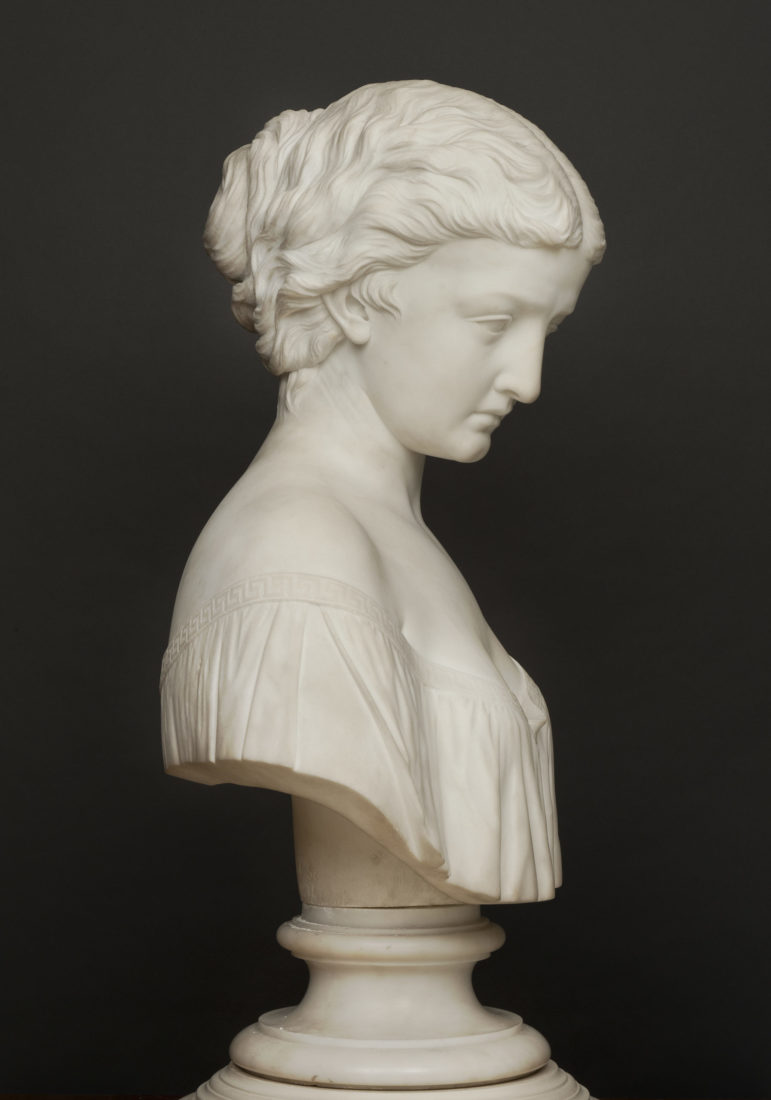For More Information
Alice Levi Duncan
Senior Director
aduncan@gpgalleryny.com
This depiction of a pensive woman- albeit lovely and young- is titled Sappho. Signed and dated 1874 by its creator Richard Henry Park (American, 1832-1902), the bust is without attributes, so the title is baffling. To answer the identity of this bust – it relates to a full figure in marble carved by Park in 1881 which show a downcast woman on the edge of a rocky precipice with a broken lyre at her feet – the vision of Sappho as a broken and distraught poet.
Sappho (630-570 BC) was one of the most famous women of the ancient world, a prolific poet and as Plato described her -the 10th Muse. Although there exists only one complete poem from the quantity of volumes she wrote and scant contemporary sources to describe her life – her celebrity and identity have been promoted by fabled interpretation and invention.
An interest in her romantic writings was revived in the late 18th century and imaginings of the poet herself began to appear. The great Neo-Classical painters – David, Gros, Girodet, Kauffman and their sculptural counterparts – Canova, Thorvaldsen and John Gibson depicted Sappho almost in mythic terms. The marble busts of Sappho relate to antique images of anonymous and pleasant looking young nymphs rather than depicting a creative and unique heroine.
In the early 19th Century, the Romantic writers interpreted her intense lyric poetry (written to be sung and accompanied by a lyre) as the essence of “the sublime”. Themes of melancholia, unrequited love and the demise of creativity paralleled the sensitivities of many writers (i.e.- Byron, Wordsworth and Tennyson). Her poetry informed their writing but also introduced visual images of the poet in a different context. For 19th Century painters and sculptors Sappho was the genius whose life and inspiration were shortened by love. According to a 4th Century text (now considered false), after she was spurned by the ferryman Phaon, she jumped to her death. There are many visual depictions of Sappho (including the present marble) which are based on this legend. Both European and American sculptors incorporated this iconography – Sappho the symbol of intellectual and creative pursuits, the embodiment of the poetry of love but also a woman weakened by depression and turmoil. Such imagery was not based on the actual reading of her verse (few could read Greek or Latin) and no publication in English translation of her texts existed until 1885.
Another side of the Sappho saga then emerged, supported by the writings of the English poet Swinburne and the depictions by Sir Lawrence Alma-Taddema. Both her birth on the island of Lesbos and the intensity and sensual character of her poetry yielded a more explicit identity- that of the lesbian icon. Sappho was revealed through her writing not only as a literary genius but also as an independent and sexually transgressive woman.
In such varied visual depictions, no real image or sense of the poet emerges and the interpretation of Sappho’s reputation, character and existence rests solely with the fragments of her writings.





